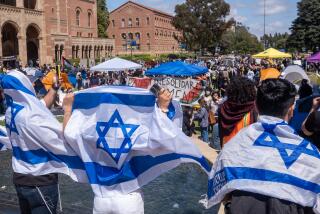Colleges Tackle Increase in Racism on Campuses
In February, amid two weeks of protests against racial incidents at Penn State University, a young white man grabbed a black student by the arm and punched her in the eye. “Why don’t you protest this,” he told her.
During the last two years, 160 U.S. colleges have reported incidents aimed at black, Latino, Asian and homosexual students and faculty members, said Howard J. Uhrlich of the National Institute Against Prejudice and Violence.
“Between 20% and 25% of all minority students on campus have been victimized at least once during an academic year,” Uhrlich said, citing incidents of verbal harassment, cross-burnings, hate literature, beatings, brawls, anti-homosexual graffiti, swastikas and racially motivated slurs.
Grew Up in Suburbs
“The heart of the problem for many large campuses like ours is that a majority of our white students grew up in suburban areas or small communities. They have had no positive experiences with minorities,” said Grant Ingle, acting director of human relations at the University of Massachusetts, where an argument over the 1986 World Series erupted into a racial brawl.
Pressured by student minority groups, colleges increasingly are naming provosts for minority affairs, recruiting and retaining more non-white teachers and creating programs to improve interracial understanding.
- A mini-course, titled “Race and Rutgers,” began this semester to review race relations at the New Jersey university since the 1960s.
- William Chace, president of Wesleyan University in Middletown, Conn., sent students a letter about racial relations on campus and the film “Mississippi Burning” about the 1964 murders of civil rights activists.
- Stanford University President Donald Kennedy reported in February on an incident in which two students were barred from campus housing for two quarters for drawing caricatures of a black on a Beethoven poster and leaving it near a black student’s door.
Ethnic Studies Requirement
- At the University of Wisconsin, 88% of freshmen this fall will have to fulfill a new ethnic studies credit requirement.
Some minority students, calling attention to the issue with protests and sit-ins, have labeled these efforts window dressing. They charge that colleges have not responded quickly enough and have not set stiff enough penalties.
Other critics question the administrators’ commitment to diversity.
“Some universities have created a (minority affairs) office or program and say they solved the problem. I see on many campuses where the minority affairs officer doesn’t have any power,” said Reginald Wilson, senior scholar at the American Council on Education in Washington, D. C.
“Yet when you ask people on campus who is responsible, they point to that person,” Wilson said. “Generally, the colleges that seem to be responding, unfortunately, are the ones where something has happened.”
Tougher Conduct Code
Since the October, 1986, World Series brawl at the University of Massachusetts, the school has instituted a tougher conduct code that more clearly defines what disciplinary action can be taken. It also has reinstated a freshman orientation program that encourages racial harmony.
“Our World Series event was the most visible major racial clash on a U.S. campus. I think we’ve been forced to do more in response than others,” said James Langley, an associate vice chancellor.
Today’s students “did not live through the civil rights movement. Some don’t know the significance of Martin Luther King Jr. Some don’t even know who he was,” Langley said. Despite efforts to recruit minorities and to keep the issue in the forefront, “We have a situation that needs close watching. This campus is not settled. It’s not calm,” he said.
“This university has not had any true commitment to diversity,” said Traci Davis, 20, of Springfield, Mass., a member of a minority-rights group on the Amherst campus. She said the university needs to redouble its efforts.
Penn State a year ago hung at its 22 campuses posters proclaiming that “Racism Has No Place at Penn State.” The posters, which bore telephone numbers for reporting incidents, were a way for the university to acknowledge that some people thought racism was a problem on campus, said Patricia Peterson, assistant vice president for campus life.
Black Women Accosted
Black students, who said five black women were accosted by whites as they walked downtown near the campus, demonstrated in February. Chanting “Racism no! Racism must go!” they demanded harsher penalties for racist acts.
‘Surface Changes’
“Right now (administrators) are doing surface changes,” said Yvette Dudley, president of the NAACP chapter at Penn State. “They say they are open to changes, but we haven’t seen any structural changes.”
Nearly a year after the Madison Plan, a blueprint for increasing minority participation, was begun on the University of Wisconsin campus, the Interfraternity Council expelled a fraternity in November for incidents that included a slave auction in which pledges in blackface and Afro wigs mimicked contemporary black entertainers. The action came a week after a university committee announced it could not punish the fraternity.
More to Read
Sign up for Essential California
The most important California stories and recommendations in your inbox every morning.
You may occasionally receive promotional content from the Los Angeles Times.










